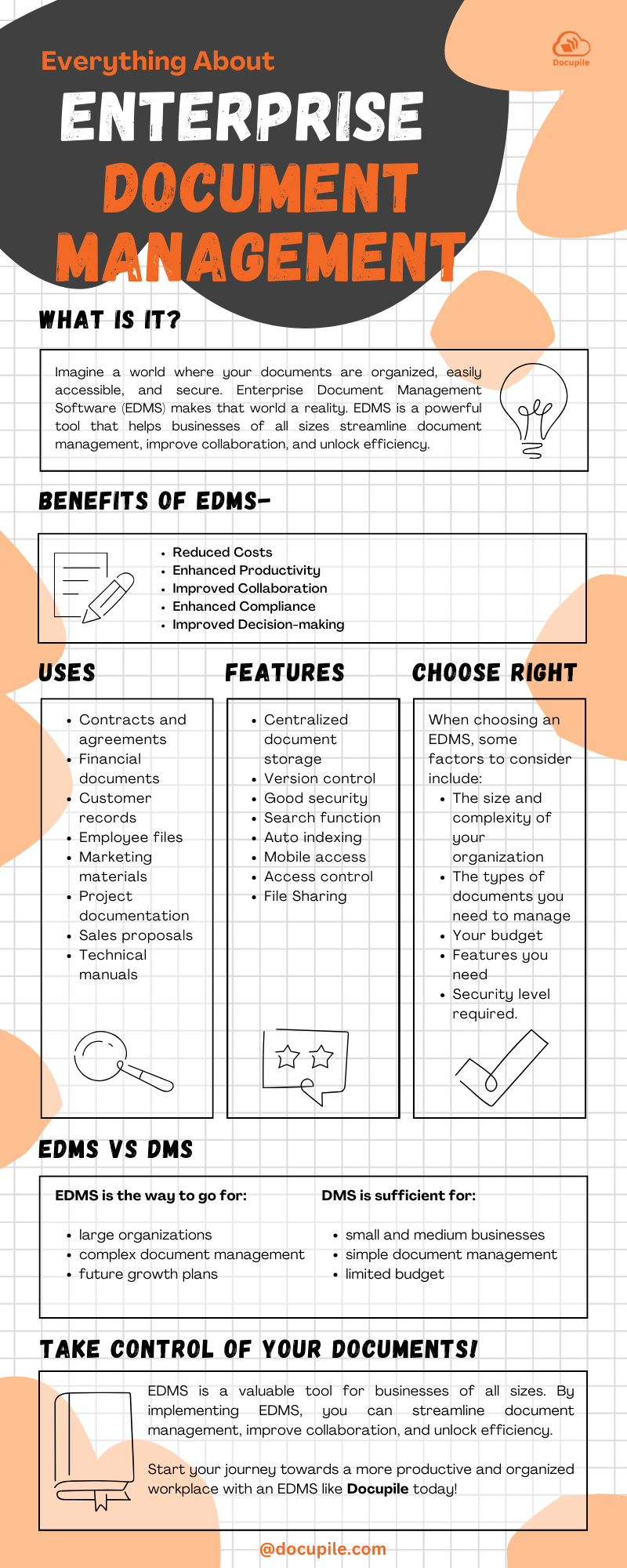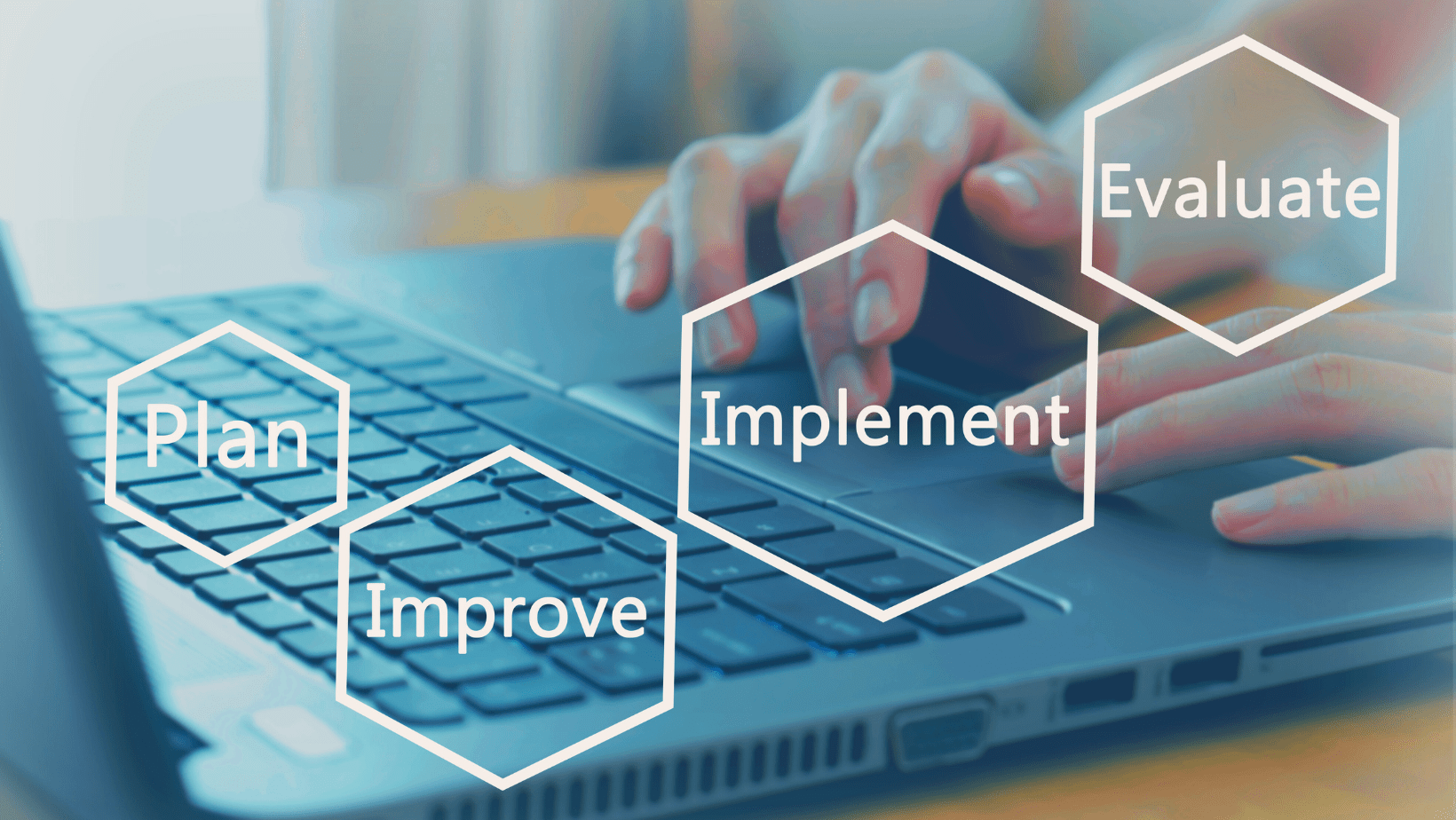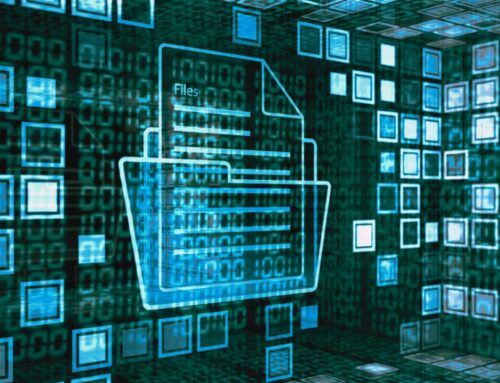Delving into Enterprise Document Management
In today’s information-driven world, businesses are grappling with an ever-increasing volume of data. Managing this vast repository of documents, contracts, and other critical information can be a daunting task, often leading to inefficiencies, lost opportunities, and even legal liabilities. This is where Enterprise Document Management Software (EDMS) steps in, offering a centralized platform to streamline document management and transform business operations.
Jump To:
Infographic:

What is Enterprise Document Management?
Enterprise Document Management Software (EDMS) is like a digital filing cabinet for your business. It helps you organize, store, and manage all your important documents electronically. This means you can easily find the information you need, share it with others, and keep track of changes. EDMS is more than just storage; it also has special features to make sure your documents are secure and easy to use.
5 Key Features of an EDMS
While most organizations have recognized the need for enterprise document management (EDM), the challenge now lies in choosing the right system for their specific needs. The software you select should have the following essential features:
These fundamental features empower organizations to meet their most pressing document management needs, including storing, retrieving, editing, sharing, and deleting documents. The chosen software should also offer customization options to accommodate any additional requirements.
Unlocking the Benefits of Enterprise Document Management Usage

Examples of EDM Software Usage:
Contract Management:
- Secure storage of contracts, agreements, and related documents.
- Version control and audit trails for tracking changes and ensuring compliance.
- Easy access to contracts for review and approval processes.
- Automated reminders for contract renewals and expirations.
- Secure collaboration on contract negotiations and revisions.
Financial Document Management:
- Centralized repository for invoices, receipts, financial statements, and other financial records.
- Automated workflows for invoice processing, approval, and payment.
- Enhanced auditability and compliance with financial regulations.
- Improved financial reporting and analysis through centralized data access.
- Efficient and secure data sharing with external auditors and partners.
Customer Relationship Management (CRM):
- Store and manage customer records, including contracts, proposals, and correspondence.
- Track customer interactions and preferences to improve service delivery.
- Automate customer onboarding and service processes for increased efficiency.
- Integrate with CRM systems to provide a unified view of customer data.
- Facilitate collaboration between sales, marketing, and customer service teams.
Human Resources (HR):
- Store employee files, including resumes, contracts, performance reviews, and training records.
- Automate HR processes, such as onboarding, leave management, and payroll.
- Secure storage of confidential employee information.
- Streamline employee training and development initiatives.
- Facilitate communication and collaboration within the HR department.
Project Management:
- Centralized repository for project documents, plans, specifications, and deliverables.
- Version control and collaboration tools for efficient project execution.
- Track project progress and identify potential roadblocks early.
- Share project documentation with stakeholders securely.
- Integrate with project management software for enhanced visibility and control.
Marketing & Sales:
- Manage marketing materials, such as brochures, presentations, and product information.
- Automate marketing campaigns and track their performance.
- Share sales proposals and presentations with clients securely.
- Collaborate on marketing content creation and approval processes.
- Integrate with CRM and marketing automation systems for better data management.
Technical Documentation:
- Store and manage technical manuals, user guides, and other technical documents.
- Version control and easy access to latest versions of technical information.
- Search functionalities for quick retrieval of specific technical information.
- Integrate with knowledge management systems for better accessibility.
- Facilitate collaboration among technical teams and support staff.
Compliance & Legal:
- Securely store legal documents, contracts, and compliance records.
- Track compliance with industry regulations and legal requirements.
- Automate document retention and disposal processes.
- Facilitate eDiscovery requests and legal audits.
- Improve risk management and reduce compliance costs.
Additional Uses:
- Research & Development (R&D) documentation management
- Product development and design processes
- Engineering drawings and specifications
- Medical records management
- Educational materials and course content
- Quality management systems
Implementing Enterprise Document Management Software:

The successful implementation of EDMS requires careful planning and consideration of business needs. Here’s a step-by-step guide:
- Assess Requirements: Clearly define the organization’s document management needs, considering factors such as document types, storage requirements, and access needs.
- Evaluate Solutions: Research and evaluate various EDMS solutions, considering factors such as scalability, features, integrations, and vendor support.
- Pilot Testing: Conduct a pilot test to assess the chosen EDMS in a controlled environment, ensuring it aligns with business requirements.
- Training and Rollout: Provide comprehensive training to employees on the usage and benefits of EDMS, ensuring a smooth rollout and adoption.
- Continuous Improvement: Regularly review and optimize EDMS usage, identifying areas for improvement and adapting to changing business needs.
Difference between EDM and ECM:
The terms “EDMS” and “DMS” are often used interchangeably, but there is a subtle distinction between the two. DMS is a broader term that encompasses any system used to manage documents. EDMS, on the other hand, is a more specialized type of DMS that is specifically designed for enterprise-level organizations with complex document management needs.
| Condition | DMS | EDMS |
|---|---|---|
| Target audience | Small to medium-sized businesses | Enterprise-level organizations |
| Scalability | Limited scalability but customizable to your needs | Highly scalable to accommodate large volumes of documents and users |
| Features | Basic document management features | Advanced features such as workflow automation |
| Security | Basic security measures but customizable | Robust security features to protect sensitive information |
| Integrations | Limited integrations with other business systems with customizing options | Extensive integrations with other business systems, such as CRM and ERP |
| Cost | Lower upfront cost | Higher upfront cost |
Final Thoughts

Enterprise Document Management Software (EDMS) is an invaluable tool for organizations seeking to optimize their document management processes, enhance collaboration, and improve decision-making. With its ability to streamline workflows, reduce costs, and ensure compliance, EDMS empowers businesses to achieve greater efficiency and success in today’s competitive landscape.




